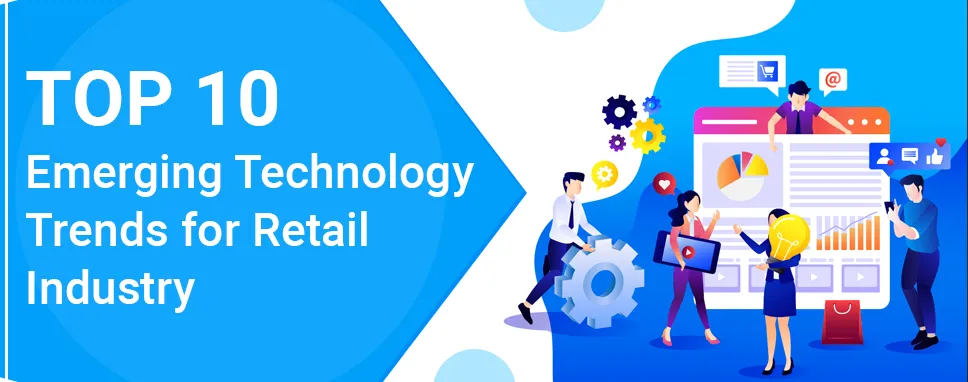Modernizing applications with the 7 R strategy – A CTO’s Guide
Think about the last time CTOs spent most of their time fixing old systems. Updates were slow, servers were expensive, and adding new features took time. Now, things have changed....
Listening is fun too.
Straighten your back and cherish with coffee - PLAY !

Having cutthroat competition in today’s market, the success of your retail industry would definitely depend on how well you perform to meet customer demands. Offering a flawless user experience is always an imperative need for the retail industry. With the waves of emerging technologies, retail industries have become more reliant on them to provide an easy and incredible user experience. Digital transformation, cloud services, networking, etc. are some of the ways the retailers are reinventing their stores.
Technologies in the retail stores not only provide a fine shopping environment but also helps with huge cost savings. Here in this blog, we will elucidate on the major technology trends which impact the Retail industry.
"Machines That Tell The Future: 2020 has shown that world-shaking, business disrupting events can come out of nowhere. Future success is going to rely on having better tools for predicting and reacting to them. That’s where machine learning comes in. For 2021, retailers want to know how COVID-19 will impact customer demand and how they can predict shifts. Machine learning is more adaptable to changes and faster to implement than traditional forecasting methods. Retailers can’t prepare for what they can’t see coming but machine learning tools should give them better vision into the world and what it wants.”
- Francesca Nicasio, Content Marketer at Payment Depot
"One significant trend for 2021 will be the increasing use of robotic automation in the retail supply chain. While a lot of noise was made about Wal-Mart’s rejection of Bossa Nova robots, the reality is that Wal-Mart and other large chains are still pursuing aggressive robotic automation plans in other areas of their operations. Most notably, the adoption of machine-learning driven robotic arms to assist with packing e-commerce orders at warehouses is fast becoming one of the most widely adopted automation practices for retailers that sell online.”
- Adam Rodnitzky, COO at Tangram Vision
“With 96% of American’s owning a mobile phone and the average U.S. citizen increasing their time spent on their phone by an additional 23 minutes per day, text messaging via short codes offers the perfect opportunity for e-commerce businesses to enjoy a direction connection and a trusted way to engage in two-way, interactive text conversations with their consumers. With a 98 percent open rate, customers can simply send a text message to a short code to get information about a product, make a purchase, and more. Seattle Sun Tan is one success story. The business implemented a text messaging campaign offering discounts to customers and within the first month, they signed up 4,750 people, totaling $196,000 in new sales and a 500% increase in money spent from their regular clientele.”
- Cliff Holsenbeck, Senior Director of Product Management at iconectiv
"In 2021, one of the significant trends in the retail industry is the use of AI in its whole operations. To cope up with the increasing demands, the use of AI will make the work of every business lighter. In dealing with customer service, the brand can easily answer people’s questions quickly. For operations, inventory management will be easier because they will get to be updated of their current stocks on hand and be reminded of any critical items to ensure the continuity of the products.”
- Jace Beeny, CEO of JaceBeeny.com
"People have no idea how much data is out there and available about them. Retailers, however, are starting to learn. As artificial intelligence advances and better tools for parsing and deriving value from all that data becomes available, retailers will rely more on new technology to offer better and more personalized offers to consumers. The long-term question is whether people will welcome the trade-off of privacy for convenience and value.”
- Todd Ramlin, Manager of Cable Compare
"*Biometric payments*: This feature is becoming more commonplace in Europe and Asia. It's likely to start growing in usage in the US and Canada this coming year, as well. A growing demand for shopping without carrying wallets or credit cards will become a new trend.
*Cash transactional data*: Despite the rise in mobile payment options, cash is still king. Retailers want to tap into the unbanked and cash-centric market and will utilize digital platforms to identify cash-paying customers and create sophisticated engagement tools.”
- Helene Berkowitz, Founder & CEO of ReceetMe
"I expect to see more online integration in physical retail next year, I don’t think we can avoid it. Looking at this year and the heavy online focus of shopping habits due to the current situation, there’s no way that retailers aren’t going to innovate in that direction in 2021. I foresee more click and collect capabilities, the ability to order in store, virtual try-on, and other aspects that facilitate a superior shopping experience that integrates the online into the physical. Who knows what retail is going to look like moving forward, but we know one thing - online is the future.”
- Hosea Chang, COO at Hayden Girls
"Bricks-and-mortar stores have been badly hit by the pandemic, with retailers like JC Penny, GameStop and Victoria’s Secret dropping hundreds of stores collectively. Despite this reality, most US consumers still prefer in-store shopping experiences, which is good news for retailers. To keep their foot traffic, however, retailers will need to find newer, safer ways for customers to shop.
Michigan-based TES America, a pioneer in touchscreen systems, is making big moves to ensure public health and safety are maintained where millions of people interact: the point of sale. TES America recently acquired major assets from another touchscreen pioneer, 3M, and plans to use improve that technology while advancing its own portfolio of safer touch experiences, including contactless monitors, anti-microbial screens, and even remote-access displays that allow employees and customers to interact with devices via their smart phones.”
- Josh Skalniak, Manager of Lambert & Co
"The biggest change for small business owners in 2021 will be in-store sales. There will be huge opportunities for digital merchants as more and more people will do their shopping online. At the same time, there’ll be more businesses clamoring for a piece of the pie than ever before, forcing them to find creative ways to stand out. To turn shoppers into loyal repeat customers, businesses will want to ensure consumers have a positive experience on the website. The ability to answer questions about your products, make recommendations and have clear policies in place will help drive repeat business.”
- Karpel Gurwicz, Head of Strategic Marketing at Wix
"Direct-to-Consumer retail brands will continue to suffer from an ultra-competitive market as Amazon and Chinese companies look to solidify their gains from the pandemic.
More people will make online purchases in 2021 yet online retailers will grapple with the rising and unsustainable cost of customer acquisition.
Online retailers will delve deeper into Instagram's clutches by offering and promoting seamless purchases on the platform. However, I expect conversion rates will be disappointing for the majority of online retailers with price points above $100.
Constantly rising costs of acquisition on Instagram will become unsustainable for many online retailers who will become more open to trying emerging retail marketplaces in 2021.”
- Suzanne Barker, Co-Founder of When I Shop
"Working in the business industry for quite some time now, something I have learned is that trends constantly change and you have to stay updated on what is new to stay on top of your game. Especially for the coming year 2021, trends will likely change due to the changes brought about by the COVID-19 pandemic.
Some trends that retailers should watch out for in 2021 are:Omnichannel. As there is still no end in sight to this global pandemic we’re experiencing, it is highly likely that more retailers will embrace the omnichannel trend. With the help of omnichannel technology, retailers will be able to bring the convenience of online shopping into offline stores and bring the experience of offline shopping into online stores.
Advanced Product Customization. As the technology that allows retailers to customize products toward the end of the manufacturing process is becoming more affordable, it is expected that more retailers can and will offer advanced product customization to their customers.”
- Sarah Graham, Content Marketing Strategist at QuikCamo
"Basically, many retail companies are interested in building and managing their own 5G networks in the same way they do with Wi-Fi - no Verizons or AT&T's required. We're talking about a business's very own 5G or LTE cellular network that spans their retail location and enables them to give their customers specific services, manage inventory, etc.
This is only possible in the last couple of months thanks to the FCC unlocking the Citizens Broadband Radio Service (CBRS) spectrum band – the largest amount of unlicensed spectrum made available to companies since Wi-Fi.”
- Jay Nichols from Nichols Communications
"With Facebook / Instagram ads hitting a saturation point, brands will shift more of their marketing to Google Shopping Ads to showcase their brand and products during the discovery and search phase, especially as eCommerce continues to dominate during the pandemic.
New data shows that brand loyalty actually rose year over year. In 2021 brands will triple down on loyalty strategies to maintain that emotional bond. They'll increase investment on their D2C brand experiences (as the majority of physical retail continues to tank), reimagine loyalty programs to make people feel like VIPs, and make tough decisions on whether or not to publicly support causes and movements.
The more we all live on our phones, the higher the likelihood that we're going to be in a texting relationship with brands. SMS marketing is on a rise with a whopping 99% engagement rate. We're going to click on a text to buy products, we're going to get VIP exclusives via SMS, and we're going to text brands directly for customer service.
With Shopify's new partnership with TikTok setting the scene, expect an avalanche of brand TikTok accounts, a tsunami of young TikTok influencers shilling their products, and the average age of TikTok audience beginning to trickle up, driving younger users out.”
- Tracy Strauss, Vice President of Marketing at Yotpo
"1. Voice assistants will fail to take off - but PC-based shopping makes a comeback. While Amazon's Alexa and Google Home have been anticipated to make consumer shopping easier (e.g. Alexa, buy me toilet paper), shoppers are still highly visual when it comes to making a purchase - we want to see the product, the specs and the cost before adding an item to checkout. With many people expecting to continue working remotely until mid 2021, PC-based shopping will see an uptick as a popular device for ecommerce purchases, particularly as people don't need to make purchases on mobile while on-the-go.
2. Small and mighty wins for small businesses. While Amazon and Walmart seem to dominate in ecommerce, consumers will increasingly elect to shop from smaller, independent brands they know, trust, and which align with their brand values. Smaller brands and merchants that can build truly meaningful relationships directly with customers through highly personalized communications will benefit from customers willing to pay a premium for their offerings.
3. Personalization and the digital customer experience will be key to retaining customers online. As shoppers might go back to physical stores as COVID-19 restrictions lift, online retailers have to battle intensely for their purchases. In order to retain their online customers, they will need to provide a seamless and positive digital shopping experience-this includes looking at the entire customer journey to anticipate key points where consumers may be most likely to churn and finding ways to proactively approach them with highly-desirable and personalized offerings.
4. D2C will gain more traction: Customer retention > customer acquisition As many retailers have closed their physical stores and/or are seeing in-store sales decline due to COVID-19, more are prioritizing e-commerce and Direct-to-Consumer models. As they execute on this strategy further in 2021, retailers will have to focus on providing a positive online shopping experience and consistently engage with their customers online to increase retention and loyalty, and ultimately sales. However, more direct interactions with their customers also means more opportunities to disappoint them, especially the most loyal buyers, leading to customer experience/retention surpassing customer acquisition strategies next year.”
- Julia Henry, Post-Purchase Manager at ParcelLab
Competition has become extremely tough for the retail industry with the waves of technology advancements. Meeting customer needs and offering the best shopping experience are the main factors that the industry tends to focus on. Technology adoption enables the retail industry to drive growth faster with less spending. Here in this blog, we have learned about major technology trends and how they impact Retail industrial development.

Think about the last time CTOs spent most of their time fixing old systems. Updates were slow, servers were expensive, and adding new features took time. Now, things have changed....

According to HackerOne, fixing a security issue after software is released can cost 30 times more than fixing it during development. Today, CTOs take a different approach. Shift...

A few years ago, companies built software first and thought about security later. Developers and security teams did not cooperate, and problems were fixed only after release. This activated DevSecOps vulnerabilities and many DevSecOps failures.